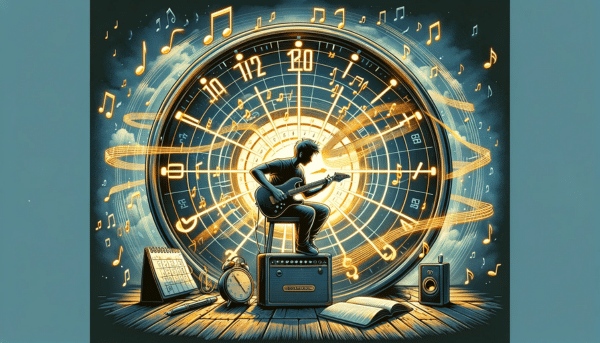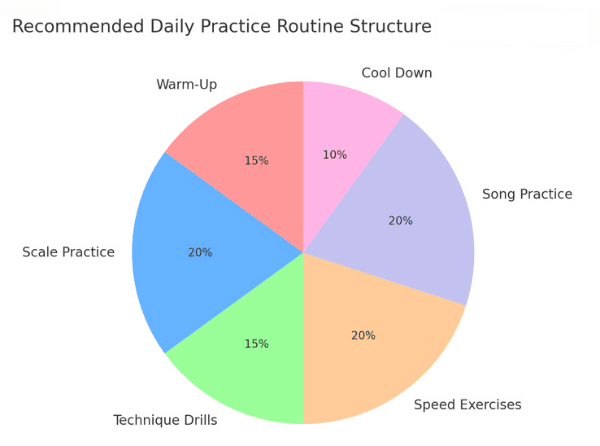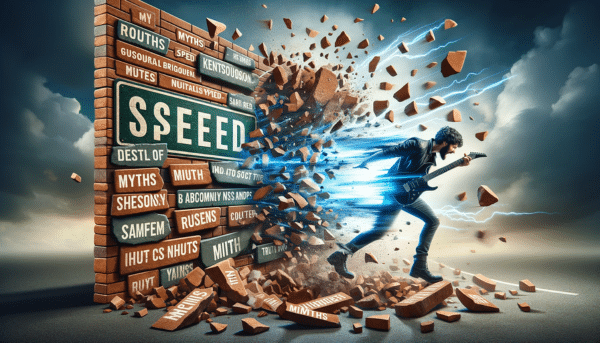Welcome to the high-octane world of guitar speed! This isn’t just about shredding; it’s about conquering the fretboard and transforming your playing into a breathtaking display of skill and passion.
Speed on the guitar is a coveted skill, a blend of precision, technique, and sheer determination. This guide is your roadmap to achieving lightning-fast fingers and a deep understanding of the guitar’s potential.
The Short Answer
To master guitar speed, start by playing slowly and build up speed without sacrificing accuracy and precision. A blend of disciplined practice, using a metronome, tablature, fretboard diagrams, and music theory can be indispensable to consistent progress. Alternate and economy picking, legato, and finger dexterity exercises are other essential techniques.
Key Takeaways

Here are the essential points to remember about building finger speed.
| Technique | Description | Benefit |
|---|---|---|
| Alternate Picking | Alternating between down and up strokes for efficiency | Increases picking speed and precision |
| 1-2-3-4 Exercise | Playing four notes per string, increasing speed with metronome | Builds finger dexterity and coordination |
| Legato | Smooth transitions using hammer-ons and pull-offs | Allows for faster note transitions without pick |
| Right-Hand Technique | Picking efficiency and rhythm accuracy, including sweep and economy picking | Essential for complex picking patterns at high speeds |
| String Gauge | Choice of string thickness affecting playability and comfort | Affects the ease of fast playing and string bending |
| Finger Independence | Exercises to improve control and precision in each finger | Enhances individual finger control and agility |
| Metronome Use | Practicing with a metronome for timing and rhythm accuracy | Improves timing, rhythm, and consistent speed |
| Musical Expression | Balancing speed with emotion and intention in playing | Ensures technical skill serves musicality |
| Hand Positioning | Proper positioning of hands for optimal reach and comfort | Reduces strain and increases speed potential |
| Warm-Up Exercises | Stretching and light playing to prepare fingers and hands | Prevents injuries and improves overall performance |
| Speed Build-Up | Gradually increasing tempo to build speed without losing precision | Ensures accuracy at higher speeds |
| Muscle Memory | Developing automatic movements through repetitive practice | Aids in playing complex passages effortlessly |
Keep On Reading (Below) To Learn More
The Pillars of Speed: Laying the Foundation

Technique – The Invisible Engine
Technique is the heart of speed. It’s the unseen force that propels your playing to new heights. Master these three techniques to propel your finger speed to the next level!
- Alternate Picking: This is where speed lives. It’s the up-down dance of the pick, the cornerstone of playing fast. Focus on smooth, efficient strokes.
- Fretting Hand Accuracy: Your fretting hand needs to be precise and agile. Train your fingers to land on the frets accurately, ensuring clarity and eliminating buzz.
- Economy of Movement: Efficiency is key. Reduce unnecessary movements, and embrace techniques like hammer-ons and pull-offs to move across the fretboard seamlessly.
The Metronome – Your Steady Guide
The Role of Metronomes in Practice: A metronome is more than just a timekeeper. As you work on conquering the fretboard, use a metronome to develop a sense of rhythm and timing. This tool is invaluable when you’re gradually increasing your speed, ensuring that your fast playing remains in time and rhythmically sound.
- Start Slow: Accuracy is the foundation of speed. Begin slowly, ensuring flawless execution.
- Gradual Progression: Incrementally increase your speed, focusing on maintaining precision at each new tempo.
- Internalize the Beat: Beyond mere speed, rhythm and groove are crucial. Let the metronome guide your timing without dominating your feel.
Variety – Expanding Your Horizons
Variety in practice keeps your journey toward speed exciting and effective.
- Diverse Exercises: Avoid getting stuck in repetitive patterns. Incorporate various picking exercises, arpeggios, chords, and licks to enhance speed skills.
- Musical Application: Apply technical skills to real songs and musical pieces, integrating your speed practice into practical playing.
- Genre Exploration: Step out of your comfort zone and explore different musical genres, each with unique challenges to improve your speed and control.
Enhancing Finger Dexterity and Hand Coordination:
As you dive into exercises like the “1-2-3-4 Exercise” and practice legato techniques, remember that you’re not just speeding up. These exercises are key to improving your finger dexterity and hand coordination, essential skills for mastering the fretboard with both speed and precision.
Building a Practice Routine for Speed

The Daily Grind
Consistency is crucial in building speed. Incorporate these elements into your daily practice:
- Metronome Workouts: Dedicate time daily to practice with the metronome, focusing on a specific technique like alternate picking or legato at increasing tempos.
- Scale Mastery: Engage in daily scale practice, exploring various patterns and techniques to enhance fluidity and speed.
- Lick Practice: Learn and perfect a new lick each day, experimenting with different tempos and rhythmic variations.
In-Depth Technique Focus
Deepen your mastery with focused practice sessions:
- Weekly Technique Exploration: Each week, focus intensely on a single technique. Utilize tutorials, instructional materials, and practice to refine your skills.
- Song-Based Challenges: Regularly tackle challenging sections of songs. Break them down, practice slowly, and incrementally build up speed.
- Jam Sessions: Engage in improvisational play with backing tracks or fellow musicians, applying your speed skills in a dynamic, real-time context.
Utilizing Fretboard Diagrams for Visual Learning
For beginners, visual aids like fretboard diagrams can be incredibly helpful. These diagrams show you where each note is located, making it easier to understand scales and chord shapes. Consider using these diagrams as a reference in your early practice sessions.
OrganizingYour Practice Sessions
Here’s a pie chart of a typical breakdown of the percentage of time you should practice each routine. Begin from warm-up and move counter-clockwise until you get to cool down.

Find a warm-up and cool-down exercise that works for you. It can be something as simple as doing the 1-2-3-4 exercise (playing four notes per string consecutively up and down the fretboard).
Be sure to use a metronome for each routine to keep everything consistent. You can buy a digital metronome to keep in your guitar case, use a metronome app on your smartphone, or use a free online metronome.
Try to spend at least an hour with this routine each day, so that:
- Warm-up = 9 minutes
- Scale practice = 12 minutes
- Technique drills = 9 minutes
- Speed exercises = 12 minutes
- Song Practice = 12 minutes
- cool down = 6 minutes
You can set a timer or just approximate it.
Demystifying Speed: Busting Common Myths

The Truth About Gear and Speed
- Expensive Gear Myth: Your speed comes from practice and technique, not high-end gear. A well-set-up guitar can help, but it’s your skill that truly matters.
Understanding Natural Talent vs. Practice
- Natural Talent Myth: While some may have a natural inclination, speed is predominantly a result of dedicated practice and efficient technique.
The Role of Practice Quality
- Practice Quality Myth: Mindless repetition is less effective than mindful, focused practice. Always aim for quality over quantity.
Speed Across Genres
- Genre Limitation Myth: Speed is not confined to specific genres. The principles of technique and practice apply universally, regardless of musical style.
Integrating Music Theory into Practice
- Music Theory Myth: Grasping the basics of music theory, like scales and chords, can significantly speed up your learning process. This understanding will help you anticipate note placements and transitions, making your practice sessions more effective.
Beyond Speed: Cultivating a Holistic Approach

The Importance of Musicality and Expression
- Remember, speed is just one aspect of guitar playing. Strive for a balance between technical prowess and emotional expression.
Dynamics and Control
- Mastering dynamics is crucial. Learn to transition between fast and slow. Play loud and soft passages with control and finesse.
Creativity and Personal Style
- Add creativity to your playing. Experiment with different styles and techniques to develop a unique musical voice.
Drawing Inspiration from Professional Guitarists
Think about guitar legends known for their mastery over the fretboard. Artists like Jimi Hendrix, Steve Vai, and Joe Satriani didn’t just play fast; they played with intention and emotion. Let their journey inspire you as you develop your own style and speed.
My Personal Encounter With Advanced Speed: A Professional’s Tale
Let me share a challenging moment from a less experienced part of my guitar journey, which involved tackling a complex solo in a recording studio.
This piece wasn’t just about playing fast; it involved intricate alternate picking, complex legato phrases, and demanding stretches.
I know I wasn’t ready for the gig, so a week before hitting the recording studio, I started by refining my alternate picking, ensuring precision at high speeds.
To improve my agility, I practiced advanced variations of the 1-2-3-4 exercise, including string skipping and irregular patterns.
For the legato sections, I focused on achieving fluid transitions between notes at a rapid pace. Proper hand positioning was crucial, especially for the wider intervals and stretches.
My warm-up routines mirrored the solo’s demands, preparing me both physically and mentally.
I continuously increased my speed and built muscle memory through repetition, ensuring each note was clean and precise. Mental preparation was key, as well as maintaining focus and confidence.
When it came time to record, I was ready. Though it took a few attempts, successfully capturing the solo was exhilarating.
This experience reinforced the importance of combining techniques, strategic practice, and mental focus in mastering advanced speed challenges on the guitar.
Seeking Guidance from Guitar Instructors: In my journey, consulting with experienced instructors provided me with valuable insights that significantly improved my technique.
If you hit a roadblock or want to refine your technique, don’t hesitate to seek advice from guitar instructors. Personalized guidance can make a significant difference in how you approach and overcome the challenges of conquering the fretboard.
Frequently Asked Questions
Here are some of the questions I get asked about finger speed and dexterity on the guitar.
If your question does not appear here, please put it in the comments, and I will get right back to you with an answer.
How Can I Avoid Finger Pain While Practicing Fast Guitar Solos?
To avoid finger pain, ensure proper hand positioning and relaxation. Start with shorter practice sessions and gradually increase the duration. Regular breaks and hand stretching exercises can also help prevent strain and discomfort.
Is It Necessary To Learn Music Theory To Play Guitar Fast?
While not strictly necessary, understanding music theory can significantly enhance your ability to play guitar fast. It aids in recognizing patterns, scales, and chord progressions, making it easier to navigate the fretboard efficiently.
What Role Does String Gauge Play In Playing Guitar Fast?
String gauge can impact playability and speed. Lighter gauge strings are generally easier to play and bend, facilitating faster playing. However, string choice is also a matter of personal preference and playing style.
Can Playing Acoustic Guitar Help Improve Electric Guitar Speed?
Playing acoustic guitar can improve electric guitar speed. The typically higher action and string tension of acoustic guitars can strengthen your fingers, making it easier to play faster on an electric guitar.
How Important Is Right-Hand Technique In Playing Guitar Fast?
Right-hand technique is crucial for playing guitar fast because it involves things like picking efficiency and rhythm accuracy. Mastering alternate, sweep, and economy picking can significantly increase your speed and fluidity.
What Are Some Common Mistakes To Avoid When Trying To Play Guitar Fast?
Common mistakes include tensing up, playing faster than your current ability allows, neglecting timing and rhythm, and not warming up properly. These can lead to sloppy playing and potential injury.
How Often Should I Practice Speed Exercises On The Guitar?
For best results, practice speed exercises daily. Consistency is key to building speed and accuracy. However, balance your practice with other aspects of guitar playing to develop well-rounded skills.
Can Finger Independence Exercises Help With Playing Guitar Faster?
Yes, finger independence exercises are beneficial for playing guitar faster. They help in developing control and precision in each finger, leading to more efficient and faster fretting.
What Is The Importance Of A Metronome In Practicing Guitar Speed?
A metronome is essential for developing timing and rhythm while playing fast. It ensures that you increase your speed without sacrificing accuracy and helps in building a consistent tempo.
How Can I Incorporate Guitar Speed Techniques Into My Solos?
To incorporate speed techniques into your solos, start by practicing licks and runs that utilize these techniques. Gradually integrate them into your solos, focusing on musicality and seamless transitions.
What Are The Benefits Of Using Legato In Fast Guitar Playing?
Legato techniques like hammer-ons and pull-offs allow smoother and faster transitions between notes. They reduce the workload on your picking hand, enabling you to play fast passages more efficiently.
How Do I Maintain Cleanliness In My Playing While Increasing Speed?
To maintain cleanliness, focus on precision and control at a slower tempo first. Gradually increase the speed while ensuring each note is articulated clearly. Regular practice of exercises focusing on clean note execution is essential to eliminate string buzzing and bad tone.
Is It Better To Learn Songs Or Exercises For Improving Guitar Speed?
Both are important. Learning songs helps apply speed techniques in a musical context, while exercises focus on specific technical aspects. A balanced approach incorporating both will yield the best results.
How Can I Overcome Plateaus In Guitar Speed Development?
To overcome plateaus, change your practice routine by introducing new exercises or techniques. Analyze your playing to identify areas for improvement, and consider getting feedback from a teacher or experienced player.
What Is The Best Way To Warm Up Before Practicing Fast Guitar Playing?
A good warm-up includes stretching your hands and fingers, followed by playing simple exercises or scales slowly. Gradually increase the tempo to prepare your hands for faster playing.
Can Guitar Pedals And Effects Impact My Ability To Play Fast?
Guitar pedals and effects can impact playability. Depending on the situation, certain effects, like distortion, can highlight or hide mistakes. Other effects, like delay, can create a sense of speed. However, they should not be relied upon to compensate for technique.
How Does Finger Strength Relate To Playing Guitar Fast?
Stronger fingers can exert more control and precision, which is vital for playing fast. Finger strength exercises and regular practice can improve both strength and speed.
What Is The Role Of Muscle Memory In Playing Guitar Fast?
Muscle memory plays a significant role in playing guitar fast. It allows your fingers to execute complex movements without conscious thought, enabling faster and more accurate playing.
How Do I Balance Speed With Musical Expression On The Guitar?
To balance speed with musical expression, focus on playing with emotion and intention, not just for the sake of speed. Use fast playing to enhance your musical ideas, and always prioritize the overall feel and message of the music. Some of the best shredders are masters of this technique!
What Are The Best Exercises To Improve Finger Dexterity For Guitar Players?
Practicing scales and chromatic exercises are highly effective for improving finger dexterity. Focus on playing each note cleanly and gradually increase the speed. Incorporate variations, like playing in different positions and using alternate fingerings, to further challenge and develop your dexterity.
Putting It All Together
In this journey of “conquering the fretboard,” you’ve learned many things to become a better guitar player. Playing guitar fast is cool, but it’s not just about moving your fingers quickly. It’s about practicing smart, being patient, and understanding your guitar.
There are different ways to pick the strings and exercises that make your fingers move faster and more accurately. You learned about alternate picking, where you quickly move the pick up and down, and the 1-2-3-4 exercise, which is like a game to train your fingers. You also discovered legato, a fancy way of playing smoothly.
Starting slow is super important. It helps you play cleanly and get better results without mistakes. You need to keep your hands in the right place on the guitar to play easier and faster. Warming up your fingers before playing is like stretching before running, so you don’t hurt yourself.
Using a metronome, a tool that helps keep your timing steady, is really helpful. You should practice different things like scales, chords, and songs to keep getting better and not get bored. And remember, playing guitar should always sound clean, precise, and musical, not just fast.
Looking Ahead: The Future of Guitar Learning: As technology advances, the way we learn guitar is bound to evolve. Imagine learning to conquer the fretboard through immersive virtual reality experiences or AI-driven personalized learning paths. The future holds exciting possibilities for guitarists.
So, keep practicing, stay patient, and have fun with your guitar! That’s how you’ll get really good at conquering the fretboard!
For a different take on the subject, see Frank’s article on learning to play fast.

Here’s a YouTube video from Guitar Control that shows you some simple exercises you can do to build up speed on the guitar. Check it out!
What’s On Your Mind?
Here’s where you get to give me your take on fretboard mastery! Don’t hold back if you have something to say or there’s a question you need answered. Jump right into the comments section below, and let it rip!
- How important is it for you to be able to play faster?
- What have you done to improve your playing speed, and how effective was it?
- Which guitar do you prefer for playing really fast passages? Why?
- What else is on your mind?
I’m here to help!


